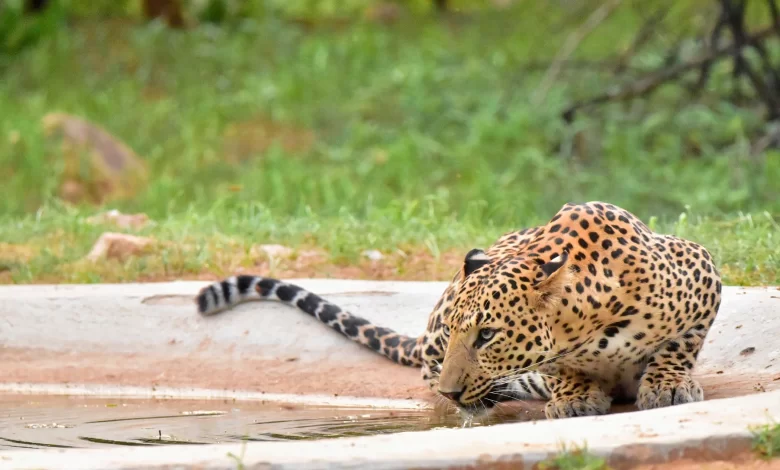Jhalana Safari Park Jaipur | Safari Timing & Best Time to Visit

Introduction
The Jhalana Safari Park Reserve, once a hunting zone for kings and royals, has lately opened to public safaris. The Jhalana Leopard Conservation Reserve, located in the heart of Jaipur’s gorgeous city, is currently home to more than 30 leopards and 5 cubs! You can also go to Shikaar Audhi, the Maharajas of Rajasthan’s three-story hunting lodge, which is located right in the center of the conservatory! There’s also an animal-spotting platform where you can watch the sunset or sunrise!
If you want to visit the Audhi, you can do so as an add-on to your package!
What you can see here
The 20-square-kilometer conservatory is home to a huge population of various Rajasthani animals, including the Striped Hyena, Desert Fox, Golden Jackal, Blue Bulls, Rhesus Macaque, and Bengal Monitor, Porcupines, Chital, Indian Palm Civets, and more. The Jhalana Safari Leopard Conservatory is also a pleasure for bird watchers, as it houses a vast population of diverse bird species such as the Indian Pitta, Dusky Eagle, Owl, Spotted Owlet, and others.
Mammalian team
The mammalian team includes the Spotted Deer, Jungle Hare, Desert Gerbil, Blue Bull, Palm Civet, Porcupine, Striped Hyena, Hanuman Langurs, Rhesus Macaques, Desert Fox, Golden Jackal, Indian Palm Squirrel, Hedgehog, and Small Indian Mongoose. Birdwatchers will like the park’s offerings. The Asian Paradise Flycatcher, Indian Eagle Owl, Indian Pitta, Indian Scops owl, Golden Oriole, Eurasian Sparrowhawk, Shikra, Nightjar, White Bellied Drongo, Brown Capped Pygmy Woodpecker, White Browed Fantail, Greater coucal, Cinereous tit, and many other species have been seen here. With 9 snake species and 2 monitor lizard species, the park has a rich reptile record. It’s the ideal spot for nature lovers, wildlife travelers, and Big Cat Safari fans to go off-roading.
Open Gypsy Safari
An Open Gypsy Safari dedicated to seeing the Jaipur Big Cat in its natural habitat of the ancient Aravallis. From our open Gypsies, you will have the finest view of the jungle. A gypsy can be booked over the phone or via email. As you reach the Wild Zone, our trained guides will assist you in spotting the creatures, which are often found in camouflaged positions and are difficult to detect with the naked eye. In an open-air gypsy, tour the reserve. You have two options for the experience: 6:45 AM to 9:30 AM or 3:30 PM to 6:15 PM, depending on your schedule.
Best time to visit
Jhalana Safari Park is best visited during the summer and winter seasons. Many migratory birds can be seen throughout the winter season So Tourists can visit Jhalana at any time of year.
Tourists can visit the park for two safaris: morning and evening.
The morning safari runs from 05:45 a.m. to 08:15 a.m. While the evening safari runs from 04:30 p.m. to 7:00 p.m. Jeeps can be reserved up to 90 days in advance.
During the monsoon season, most of the country’s protected areas are closed, but there’s something to make up for it.
Though one can enjoy the Jhalana Leopard Safari and marvel at the beautiful Leopard at any time. The months of November to April are considered to be the finest for visiting Jhalana Reserve because the weather is pleasant and nature is in full bloom, emphasizing the forest’s splendor.
GETTING TO THE JHALANA LEOPARD RESERVE:
By Air:
The Jaipur International Airport is about 6 kilometers from the Jhalana Leopard Reserve, which takes around 15 minutes to reach by car. There are numerous local and international flights linking Jaipur to places around India and overseas. To travel to Jhalana Safari Park, take a taxi, cab, or bus from Jaipur airport.
By Rail:
This is around 11.7 kilometers from the forest. You can either hire a taxi or use the local bus to get from the station to Jhalana.
By Route:
A direct road passes through the Jhalana forest reserve. Connecting it to cities such as Mumbai, Ahmedabad, Udaipur, Kota, and others, which are further connected to India’s major cities.






